Super User
Huge savings made at leachate treatment plant
At a landfill’s leachate treatment centre, where floating biomass was reducing the plant’s throughput, the introduction by Viridian Systems of a new mixer has created annual savings on chemicals of around £85,000.
From sludge taking well over two hours to settle (with unnecessary amounts still floating), it has now been reduced to less than 30 minutes. With the plant set up for two batches per day, this potentially adds back three hours of treatment time per day, which equates to more than 14,000m3/year of leachate that no longer has to be tankered off site; equating to a further annual saving of £285,000.
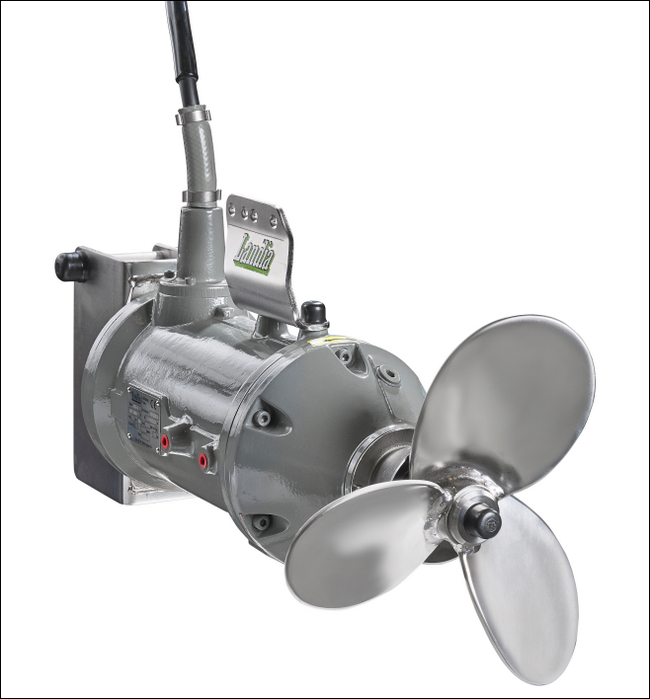 Viridian Systems chose a Landia mixer to help address issues at a leachate treatment plant
Viridian Systems chose a Landia mixer to help address issues at a leachate treatment plant
As Viridian Systems’ Managing Director, Roger Dixon explains, the new mixer (made by Landia) has now completely eliminated the problematical filamentous bacteria.
‘The right amount of agitation’
“To solve the problem for the leachate treatment plant”, he said, “we believed that with the correct type of mixer; suitably positioned, powered and timed, the right amount of agitation would disperse the floating layer to allow solids to settle much more quickly”.
‘No more floating biomass’
He added: “Undesirable filamentous bacteria, which is one of the main causes of floating biomass, is detrimental to SBRs, but working closely together with Landia, who have vast experience in mixer applications, the sub-surface liquor is now degassed; meaning no more floating biomass”.
As the plant began to produce far less unwanted foam, Birkenhead-based Viridian Systems asked the plant operator to gradually reduce dosing with de-foaming agent (antifoam) until the consumption rate falls to around 1-2 drums/month, instead of 2-3 drums/day, which will not only save around £70-100k/year, but will also reduce the dissolved organics (measured as chemical oxygen demand C.O.D.) in the treated effluent.
Furthermore, the installation of the Landia mixer has also enhanced the reliability of the plant’s Dissolved Oxygen (D.O.) (optical) probe, because there is less foam to blind it. With the probe now working as it should, there is better control of the blower speed, reducing its energy consumption, which in turn, offsets some of the power consumed by the mixer.
Viridian Systems’ Roger Dixon concluded: “Far from just supplying a mixer, Landia shared our goal in wanting to find the best possible solution. What has been achieved provides considerable ongoing benefits for our customer. As a result of this success, we have also installed a Landia mixer in a tank adjacent to the SBR”.
SWISS equips entire Boeing 777-300ER fleet with AeroSHARK
SWISS has decided to equip its entire Boeing long-haul fleet with the fuel-saving AeroSHARK surface technology. Starting in the middle of the year, a total of twelve Boeing 777-300ERs will gradually be fitted with the riblet films developed jointly by Lufthansa Technik and BASF. The significantly reduced frictional resistance resulting from this modification will make the sub-fleet more than one percent more fuel-efficient and lower in emissions.
Swiss International Air Lines (SWISS) is the first passenger airline worldwide to use the innovative surface technology to significantly reduce fuel consumption and emissions of one of its existing fleets, thereby improving both economy and ecology. With approximately 950 square meters of riblet film, the modification of the “long” Boeing 777-300ER will be even larger than the 800 square meters on the Boeing 777F of AeroSHARK's launch customer Lufthansa Cargo. The potential for fuel and CO2 savings on this scale is around 1.1 percent. Converted to the operational profile of the Boeing 777-300ER at SWISS, this means annual savings of more than 4,800 tons of kerosene and roughly 15,200 tons of carbon dioxide, as much as is usually generated on approximately 87 long-haul flights from Zurich to Mumbai.
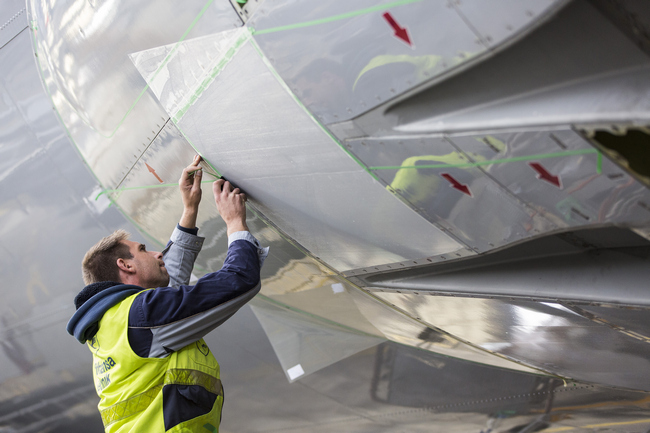 Application of the riblet film on an aircraft. (Photo: Lufthansa Technik AG)
Application of the riblet film on an aircraft. (Photo: Lufthansa Technik AG)
“Reducing our environmental footprint is one of the biggest challenges facing the aviation industry, and becoming carbon-neutral until 2050 is an important strategic goal for SWISS,” said Dieter Vranckx, Chief Executive Officer of SWISS. “We are keen to actively promote and invest in the use of new technologies. We are pleased to be the world's first passenger airline to offer the innovative AeroSHARK technology on our Boeing 777 fleet, making another important contribution to more sustainable air travel in the future.”
“Due to the long lifecycles in our industry, we cannot only rely on new aircraft generations to reduce our environmental footprint, but also need to specifically optimize existing fleets towards sustainability,” explained Dr. Johannes Bussmann, Chief Executive Officer of Lufthansa Technik. “AeroSHARK makes a significant contribution to this, and I am very pleased that SWISS is leading the way.”
“In developing our Novaflex Sharkskin surfaces, the focus was on a robust yet functional solution that meets the stringent requirements of aviation and also helps our customers achieve their sustainability goals,” said Uta Holzenkamp, head of BASF's Coatings division and in this position also responsible for functional films. “The fact that SWISS is convinced by our solution shows that economic action and sustainability go hand in hand.”
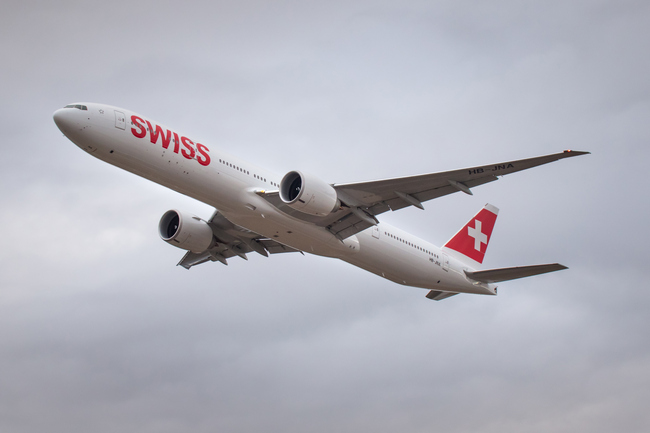 A total of twelve Boeing 777-300ERs will gradually be fitted by SWISS with the riblet films developed jointly by Lufthansa Technik and BASF. (Photo: SWISS International Air Lines)
A total of twelve Boeing 777-300ERs will gradually be fitted by SWISS with the riblet films developed jointly by Lufthansa Technik and BASF. (Photo: SWISS International Air Lines)
SWISS will install AeroSHARK on its Boeing 777-300ER fleet successively from mid-2022 during suitable maintenance layovers. The airline had already supported Lufthansa Technik and BASF during the development phase of AeroSHARK: In the summer of 2021, a Boeing 777 wing was precisely measured for the entire duration of a regularly scheduled flight between Zurich and San Francisco. With the data collected, Lufthansa Technik was subsequently able to create highly accurate 3D models for flow simulations, on the basis of which the AeroSHARK modification is to be extended to the wings of the Boeing 777 in the near future in order to realize further savings potential. SWISS will also provide one of its aircraft for the so-called STC flight to obtain the required Supplemental Type Certificate from the European Union Aviation Safety Agency (EASA).
AeroSHARK is a surface technology developed jointly by Lufthansa Technik and BASF that consists of ribs around 50 micrometers in size - known as riblets. It specifically imitates the properties of sharkskin, which has particularly favorable flow characteristics, and thus optimizes aerodynamics at relevant points on the aircraft. As a result, less fuel is needed overall. Lufthansa Technik and BASF intend to systematically develop the new technology further in the direction of additional aircraft types and even larger surfaces, so that in the future they will be able to provide airlines around the world with even more extensive support in achieving their emissions targets. In initial model calculations, the sharkskin technology in its maximum expansion stage could even avoid CO2 emissions to the tune of up to three percent.
About BASF:
At BASF, we create chemistry for a sustainable future. We combine economic success with environmental protection and social responsibility. More than 110,000 employees in the BASF Group contribute to the success of our customers in nearly all sectors and almost every country in the world. Our portfolio is organized into six segments: Chemicals, Materials, Industrial Solutions, Surface Technologies, Nutrition & Care and Agricultural Solutions. BASF generated sales of €59 billion in 2020. BASF shares are traded on the stock exchange in Frankfurt (BAS) and as American Depositary Receipts (BASFY) in the U.S. Further information at www.basf.com.
About BASF’s Coatings division:
The Coatings division of BASF is a global expert in the development, production and marketing of innovative and sustainable automotive OEM and refinish coatings, decorative paints as well as applied surface treatments for metal, plastic and glass substrates in a wide range of industries. This portfolio is supplemented by "Beyond Paint Solutions", which enable new applications with innovative surfaces. We create advanced performance solutions and drive performance, design and new applications to meet our partners’ needs all over the world. BASF shares skills, knowledge and resources of interdisciplinary and global teams for the benefit of customers by operating a collaborative network of sites in Europe, North America, South America and Asia Pacific. In 2020, the Coatings division achieved global sales of about €3.1 billion
Further information at www.basf-coatings.com.
About Lufthansa Technik:
With some 35 subsidiaries and affiliates, the Lufthansa Technik Group is one of the leading providers of technical aircraft services in the world. Certified internationally as maintenance, production and design organization, the company has a workforce of more than 22,000 employees. Lufthansa Technik’s portfolio covers the entire range of services for commercial and VIP/special mission aircraft, engines, components and landing gear in the areas of digital fleet support, maintenance, repair, overhaul, modification, completion and conversion as well as the manufacture of innovative cabin products.
About SWISS:
Swiss International Air Lines (SWISS) is Switzerland's largest airline. It connects Switzerland to Europe and the world with direct flights from its national airports in Zurich and Geneva. To do so, it operates one of Europe's youngest and most fuel-efficient fleets. Its freight division, Swiss WorldCargo, offers a comprehensive range of airport-to-airport services for high-value goods and care-intensive cargo. As Switzerland's airline, SWISS stands for its traditional values and is committed to the highest product and service quality. SWISS is part of the Lufthansa Group and a member of the Star Alliance, the world's largest network of airlines.
Chevron to Seek Project Canary Certification of Select North American Upstream Assets
Partnership enhances Chevron’s approach to advancing a lower carbon future
Chevron Corporation (NYSE: CVX) has just announced a pilot project with Project Canary to independently certify operational and environmental performance in the company’s North American upstream region.
“Chevron is focused on delivering reliable, lower carbon energy to a growing world. We aim to achieve this through innovation, both in our application of technology, and in our approach to how we design and run our operations,” said Steve Green, president, Chevron North America Exploration and Production. “We’re pleased to work with Project Canary to pilot an independent well-by-well certification at five sites, enhancing our ability to demonstrate transparency in how we are lowering methane emissions in our operations.”
 Project Canary, a mission-driven B-Corp, will use its comprehensive TrustWell™ Certification program to review and analyze aspects of the environmental and social performance of individual wells and facilities in the Permian Basin of Texas and the DJ Basin of Colorado. Chevron will also deploy Canary X continuous, pad-level methane emissions monitoring units at select locations.
Project Canary, a mission-driven B-Corp, will use its comprehensive TrustWell™ Certification program to review and analyze aspects of the environmental and social performance of individual wells and facilities in the Permian Basin of Texas and the DJ Basin of Colorado. Chevron will also deploy Canary X continuous, pad-level methane emissions monitoring units at select locations.
More than 600 data points within 24 operational categories are included in a Project Canary TrustWell™ analysis. Operators who earn top rankings are determined by Project Canary to utilize the highest standards and practices across their operations.
The companies expect the TrustWell™ certification process to begin in the first half of 2022 and, based on ratings earned during the review process, anticipate being ready to deliver certified Responsibly Sourced Gas (RSG) to market by mid-2022.
“Chevron is a leader in advancing solutions that deliver reliable energy and address U.S. methane emissions. We’re grateful for the opportunity to leverage our ESG technologies to help further advance their business priorities,” Chris Romer, co-founder and CEO of Project Canary, said. “With our rigorous third-party review, measured performance and continuous action, buyers can have confidence that Chevron is delivering responsible lower carbon energy.”
In 2020, Chevron’s U.S. onshore production methane intensity was 85% lower than the U.S. industry average. The company continues to design, construct, and operate facilities with an eye toward limiting fugitive emissions. For example, it has reduced fugitive methane and volatile organic compound emissions in U.S. onshore operations through leak detection and repair, low-/no-emissions pneumatic devices, and centralized production facilities. The company is also expanding its methane detection capabilities to identify the best opportunities to further lower emissions.
About Chevron
Chevron is one of the world’s leading integrated energy companies. We believe affordable, reliable and ever-cleaner energy is essential to achieving a more prosperous and sustainable world. Chevron produces crude oil and natural gas; manufactures transportation fuels, lubricants, petrochemicals and additives; and develops technologies that enhance our business and the industry. We are focused on lowering the carbon intensity in our operations and seeking to grow lower carbon businesses along with our traditional business lines. More information about Chevron is available at www.chevron.com.
About Project Canary
Project Canary delivers trusted and reliable, independent Energy ESG data. They are the leaders in the certification of responsible operations throughout the energy value chain and provide measurement-based emission profiles via continuous monitoring technology. Their work helps identify the most responsible energy supply chain operators. Analyzing more than 600 operational data points, TrustWell by Project Canary is the most comprehensive well-pad and mid-stream certification program available. Project Canary is the recognized badge of high standards. Formed as a Public Benefit Corporation, Project Canary’s team of scientists, engineers, and seasoned industry operators have earned recognition for their uncompromising standards, including being named “Best for the World 2021" B Corp. Visit www.projectcanary.com to learn more.
EUROCELL AIMS TO LEAD THE ELECTRIC FUTURE IN EUROPE’S RAPIDLY GROWING ENERGY STORAGE MARKET
Eurocell, the Anglo-Korean next-generation battery company, is primed to take advantage of the rapidly-growing energy storage market, predicted to be worth $30BN by 2030.
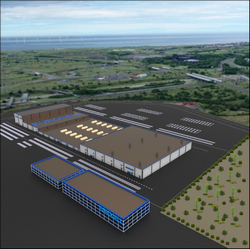 The company’s proven batteries, which are now ready for scaled-up manufacturing, are perfectly suited to energy storage. They last over 10 times longer than conventional lithium-ion technologies, reducing virtually all ‘end of life’ issues. A wide range of operating temperatures also makes them ideally suited to areas with extreme weather and for off-grid solutions. Eurocell’s batteries are also safer than conventional batteries, with a vastly reduced risk of thermal runaways and fire risks in buildings.
The company’s proven batteries, which are now ready for scaled-up manufacturing, are perfectly suited to energy storage. They last over 10 times longer than conventional lithium-ion technologies, reducing virtually all ‘end of life’ issues. A wide range of operating temperatures also makes them ideally suited to areas with extreme weather and for off-grid solutions. Eurocell’s batteries are also safer than conventional batteries, with a vastly reduced risk of thermal runaways and fire risks in buildings.
Eurocell is now in advanced discussions with European customers including:
- Next-generation housing companies and property developers, where its batteries will be used to harness energy created from wind and solar sources to power future homes.
- A world-leading off-grid plant hire business wanting advanced, high-tech lighting solutions and generators to silently power outdoor events with zero-emission energy.
- A major energy company needing high performance and long-lasting battery storage solutions to balance the grid – providing affordable and stable energy at times of peak demand.
Recardo Bruins, CEO Eurocell EMEA, commented: “Quite rightly, a lot of the debate so far has been about the electrification of vehicles but we think it’s time to discuss the wider electrification of society. That’s not just about how we electrify our cars, but how we will charge them while providing renewable off grid solutions and powering our industry and homes.
“This is why Eurocell’s market leading batteries, which we will start producing next year, are so crucial. Their performance, safety and longevity make them ideal for ‘smart’ homes and offices where you can store renewable energy, or energy from the grid at the cheapest tariff and then deploy it when you want to. If we want to meet Net Zero targets and live in a clean and sustainable carbon-free world, then it’s essential we urgently find ways to electrify all aspects of our lives from renewable sources, and Eurocell will be a key enabler of this.”
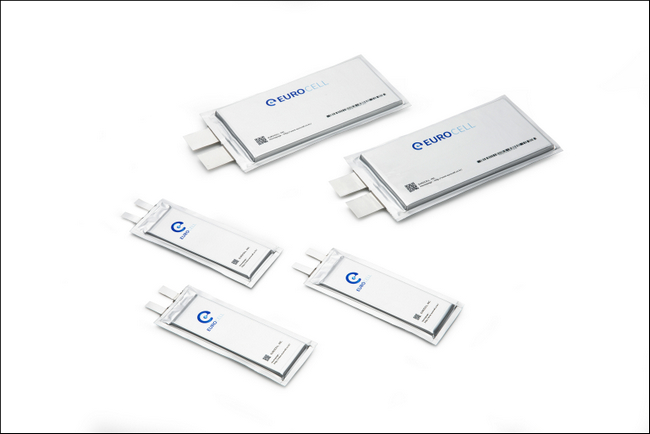
Eurocell is now firmly on track with plans to build its first European Gigafactory, producing proven ‘production ready’ technologies in just 12 months, with full capacity coming as early as 2025.
- Eurocell is in advanced discussions with major property developers and energy companies to supply batteries to store energy from renewable sources, enabling Net Zero targets
- Anglo-Korean battery manufacturer, Eurocell, is building a Gigafactory in Western Europe to supply the $30BN energy storage market
- Eurocell’s South Korea developed, market-leading batteries to begin mass production in just 12 months
- Eurocell batteries are safe, higher performing in every condition and last 10 times longer than conventional lithium-ion cells – eradicating all ‘end of life’ issue
- New European home of Eurocell will benefit from huge jobs and investment boost, as well as the transfer of world-leading skills and South Korean technology
The company will mass-produce and export its market-leading technologies from one of three key markets, the UK, the Netherlands or Spain. It is already actively looking at sites and the final choice is heavily dependent on the right combination of local support measures, strategic benefits and site infrastructure. With some governments moving faster than others it’s likely that the most advanced proposal will be the final location.
The host country selected will benefit from the creation of hundreds of direct and indirect jobs, transferring vital skills from South Korean battery experts and boosting the economy in a strategic sector crucial to achieving Europe’s Net Zero ambitions.
About Eurocell
Eurocell-EMEA is an Anglo-Korean company specialising in disruptive next-generation battery technologies. It is committed to building a European Gigafactory to supply world-leading production-ready batteries by 2023 and will be at full capacity by 2025.
The company uses verified and proven technology, developed by world-class South Korean developers, delivering higher performance than conventional lithium-ion batteries. They are safer, faster charging and discharging, longer lasting and able to operate in more extreme temperature conditions. As such they are ideally suited for all applications, including residential and distributed storage, charging infrastructure, automotive and mobility and auxiliary power systems.
Eurocell EMEA is a trading brand of FIC EMEA Ltd. FIC EMEA Ltd is a joint venture company between FIC Advanced Materials UK Ltd and three leading South Korean battery technology companies, namely: FIC Advanced Materials Inc; Indong Advanced Materials Inc; and Eurocell Inc.
ANDRITZ to supply another high-efficiency PowerFluid circulating fluidized bed boiler to Japan
International technology group ANDRITZ has received another order from the HITACHI ZOSEN Corporation in Japan to supply a 52.7-MW PowerFluid circulating fluidized bed (CFB) boiler on EPS basis. The boiler will be part of the biomass power plant in Fukuyama, Hiroshima Prefecture, in Japan. Start-up is planned for 2025.
The ANDRITZ PowerFluid boiler will be integrated into a biomass-fired power generation facility that will be fueled by wood pellets, wood chips and palm kernel shells. With its high efficiency and state-of-the-art technology, it is the perfect solution to meet greenhouse gas reduction targets and contribute towards carbon neutrality in Japan. The biomass power plant will be capable of supplying power for roughly 110,000 Japanese households.
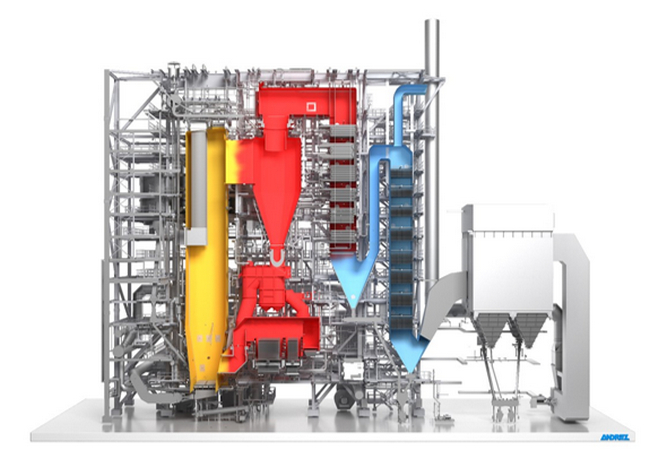 ANDRITZ PowerFluid circulating fluidized bed boiler. “Photo: ANDRITZ”.
ANDRITZ PowerFluid circulating fluidized bed boiler. “Photo: ANDRITZ”.
The new CFB project is the thirteenth ANDRITZ advanced CFB boiler for the Japanese market and demonstrates the excellent position ANDRITZ has in the biomass power plant market.
This order once again confirms ANDRITZ’s strong partnership with the HITACHI ZOSEN Corporation. ANDRITZ is proud to be part of this remarkable project and make another important contribution towards the Japanese power industry’s move from fossil fuel to renewable energy resources.
ANDRITZ GROUP
International technology group ANDRITZ offers a broad portfolio of innovative plants, equipment, systems and services for the pulp and paper industry, the hydropower sector, the metals processing and forming industry, pumps, solid/liquid separation in the municipal and industrial sectors, as well as animal feed and biomass pelleting. Plants for power generation, flue gas cleaning, recycling, and the production of nonwovens and panelboard complete the global product and service offering. Innovative products and services in the industrial digitalization sector are offered under the brand name Metris and help customers to make their plants more user-friendly, efficient and profitable. The publicly listed group has around 26,800 employees and more than 280 locations in over 40 countries.
ANDRITZ PULP & PAPER
ANDRITZ Pulp & Paper provides equipment, systems, complete plants and services for the production of all types of pulp, paper, board and tissue. The technologies and services focus on maximum utilization of raw materials, increased production efficiency and sustainability as well as lower overall operating costs. Boilers for power generation, flue gas cleaning systems, plants for the production of nonwovens and panelboard (MDF), as well as recycling and shredding solutions for various waste materials also form a part of this business area. State-of-the-art IIoT technologies as part of Metris digitalization solutions complete the comprehensive product offering.
Siegwerk to revolutionize Indian packaging; launches VEGA - Mineral Oil Free Inks
Siegwerk, one of the leading global providers of printing inks and coatings for packaging applications and labels headquartered in Germany, has announced the launch of its ‘Mineral Oil Free Ink’ range in the Indian market. Mineral oils as a huge group of chemicals, have earned disrepute globally for their bad toxicological profile with several research studies confirming the migration of mineral oils into the food. The uptake of specific mineral oil hydrocarbons (MOHs) is seen as a potential health hazard, as some saturated mineral oils (MOSH) may accumulate in human tissue while some Aromatic Mineral oils (MOAH) may even cause cancer.
- Siegwerk’s Bhiwadi plant will be 100% Mineral oil-free with effect from 1st May 2022, making the company the first in India to do so
- The move is in line with Siegwerk’s commitment to becoming a positive circular economy driver
In an exclusive virtual event for the launch of the mineral-oil free ink line, titled the VEGA series, Siegwerk announced its achievement of 100% food safe operations in India. The launch marks the transformation of Siegwerk’s Bhiwadi manufacturing unit into a fully mineral-oil free plant.
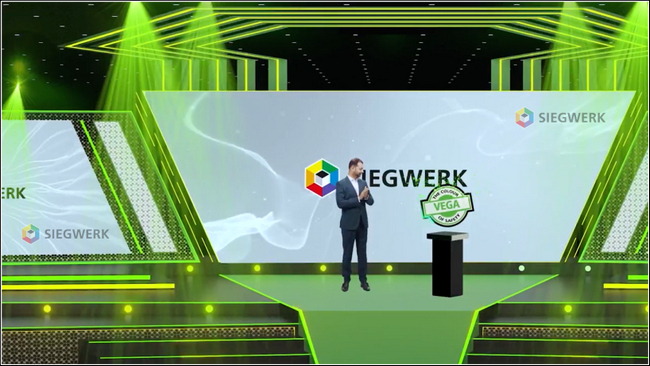
While announcing the launch of Mineral Oil free Ink range, VEGA, Mr. Ramakrishna Karanth, CEO, Siegwerk India sub-continent said, “In the past few years, scientific journals have published analyses on the hazardous effects of mineral oil hydrocarbons (MOHs) and saturated mineral oils (MOSH) in food packaging. The manifold adverse effects make it an issue related to consumer safety and occupational safety. We at Siegwerk nurture an inflexible safety culture with focused commitment to improve end-consumer and environmental safety. As a market leader for safe inks and as a strong proponent of safety, we have proactively stopped the use of toxic ingredients before any legislations on their prohibition are established. Siegwerk India will henceforth be supplying inks that do not contain mineral oils from its blending centers in India”.
Mr. Ashish Pradhan, President, Siegwerk Asia unveiled the new line of mineral-oil free inks. The versatile ink series consist of Vega Prorich, Vega Impression, Vega Nature LT, Vega Sprint, Vega Vibrant+ and Vega Prime ink lines – which cater to their respective specializations.
Mr. Ashesh Mukherjee, Vice President & Business Head, Sheetfed Business, Siegwerk India, also commented at the launch, “The Vega line is the brainchild of Siegwerk’s key principles like innovation, safety and ability to offer superior products & services. Vega embodies rich color strength, excellent printing quality with dot sharpness, brighter color share & high gloss and excellent drying properties, all set to transcend consumer expectations. With VEGA, we set out on a journey to ensure safety of our supply chain partners as well as the end consumers”.
A captivating addition to the mega launch, Mr. Harsha Bhogle, renowned cricket commentator and management consultant, was the special guest speaker at the event.
The apex quality and safety regulators in India - Bureau of Indian Standards (BIS) and Food Safety and Standards Authority of India (FSSAI) have spotlighted the importance of packaging safety through the Food safety and Standard (Packaging) Regulations, 2018 and its revisions. Even prior to any such legislations, Siegwerk has been an avid advocate of non-toxic inks with uncompromised commitment towards product safety. The company has completely phased out its ‘Tempo brand’, replacing it with ‘VEGA’, its mineral-oil free ink line. Siegwerk’s VEGA line was launched in response to a growing demand for transparency and safer ingredients in packaging products. These inks were designed with the 3 S’s in mind – Safety, Sustainability and Satisfaction of the customer., Siegwerk has always pledged its alliance to safe inks, discarding hazardous solvents like mineral oils and Toluene, and continue to accelerate their efforts in this direction.
About Siegwerk
Siegwerk, a sixth-generation family-owned company, is one of the leading international manufacturers of printing inks and individual solutions for packaging, labels, and catalogues. With more than 180 years of experience, the company has solid expertise in and knowledge of many printing procedures. A global manufacturing and service network ensures customers consistently high-quality products and services. In keeping with the company’s philosophy “Ink, Heart & Soul,” Siegwerk seeks long-term cooperation with its business partners. Siegwerk employs some 5,000 people worldwide in more than 30 country organizations and is headquartered in Siegburg near Cologne.
Further information on Siegwerk can be found at www.siegwerk.com
Moxa Achieves IEC 62443 Standard Security Requirements to Futureproof Next-generation Networking
Moxa Inc., a leader in industrial communications and networking, with a focus on securing industrial networks, is thrilled to announce that the company has obtained the world’s first IEC 62443-4-2 certification for industrial networking devices, as per the International Electrotechnical Commission for Electrical Equipment (IECEE) Certification Body Scheme. The certification is for one of the company’s next-generation networking solutions, EDS-4000/G4000 Series, due to hit the market in the upcoming March.
As recognized by IEC 62443-4-2 and IEC 62443-4-1 certifications, Moxa's solutions aim to unite networking and OT cybersecurity with layered defense-in-depth approach. Our solutions cover security-hardened networking devices based on the IEC 62443-4-2 cybersecurity standard, advanced IT and OT network segmentation with threat prevention, and tailored OT deep packet inspection (DPI) realizing industrial intrusion prevention system (IPS). These offerings allow Industrial Automation and Control Systems (IACS) to be built with reliable end-to-end connectivity to provide robust hardware, as well as high-performance and dependable networks.
“The IEC 62443 series of standards cover all aspects of security requirements, thus providing a common language for component suppliers, system integrators and asset owners”, says Steve Mustard, 2021 President of International Society of Automation (ISA), the Standards Development Organization responsible for IEC 62443. “The standards outline a secure-by-design approach and provide requirements through to product manufacturing. This significantly simplifies the procurement and integration processes for network devices, applications, and automation control devices that make up industrial control systems.”

“When we pursued the certification of the IEC 62443 standards, the journey was transformational for Moxa,” said Samuel Chiu, general manager of Moxa Networking. “We demonstrated that security is part of the DNA of Moxa’s product and solution portfolios by complying with the internationally recognized standards related to the process and product requirements for the secure development of an IACS. This benefits our customers who must now utilize these solutions to enjoy undisrupted operations during every step of their digital transformation."
According to IDC’s Worldwide IT/OT Convergence 2022 Predictions*, 75% of new operational applications deployed at the edge will leverage containerization by 2024. This will enable a more open and composable architecture, which will be necessary for resilient operations. The rise in edge devices and expanded connectivity represent a pathway into operations. They are being deployed at a high rate and utilize more open architectures and capabilities compared to the isolated automation systems of the past. These devices must have both their software and hardware elements developed securely to last throughout their product lifecycle, integrate seamlessly into the network overall, and have security management capabilities.
“Networking and cybersecurity have strong synergies in operations settings, yet they both must be purpose-built for OT environments. With the digital future and increased connectedness of operations, new industry requirements and standards will be put in place to ensure providers can keep up with these requirements,” said Jonathan Lang, research director of IDC with a focus on Worldwide IT/OT Convergence Strategies. “These specialized industry requirements can be overlooked by many IT cybersecurity solutions, and combining subject matter expertise and capabilities from operations is critical to ensure integrity of security systems.”
To create a foundation for futureproof operations, many system integrators require that component suppliers comply with the subsections of the IEC 62443 standard that pertain to their devices. The software development process-related IEC 62443-4-1 and the product-related IEC 62443-4-2 standards highlight the importance of selecting vendors that provide hardened hardware components built with a “secure by design” approach.
* IDC FutureScape: Worldwide IT/OT Convergence 2022 Predictions, Doc #US47131521, October 2021.
www.moxa.com
New CNC software simplifies usage of latest five-axis machine tools
Available now, the latest version of Flexium software from CNC specialist NUM includes an enhanced RTCP (Rotation Tool Centre Point) function with tool vector programming that significantly simplifies the usage of five-axis machine tools.
- Enhanced RTCP function with tool vector programming
- New G code command and smoothing algorithms help improve surface quality
As one of the original developers of RTCP, NUM continually enhances the function to meet the changing needs of machine builders and end-users. The company’s implementation of RTCP includes twenty-four predefined kinematic configurations and its Flexium+ CNC systems can accommodate different kinematics on the same machine – for example, when different milling heads are needed.
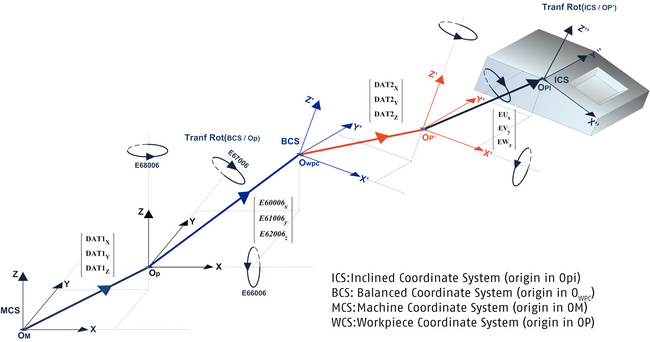 NUM’s Flexium CNC software now includes an enhanced RTCP function with 3D workpiece compensation that significantly simplifies the programming of five-axis machine tools.
NUM’s Flexium CNC software now includes an enhanced RTCP function with 3D workpiece compensation that significantly simplifies the programming of five-axis machine tools.
NUM’s basic RTCP function, invoked by ISO code G151, offers a number of user-specified variants. The function can be activated with an inclined coordinate system or after a positioning move. In either case, the CNC system automatically calculates the mechanical offset to ensure that the tool centre point is always in touch with the defined workpiece surface while the rotary axes are moving. The RTCP function can also be activated by the actual positions of the rotary axes.
Until now, programming 5-axis machines has often been considered an onerous task. The rotary axes are usually programmed directly with their angular position, which has the advantage that the position of the machining head can be imagined when viewing the part program. The disadvantage, however, is that the part program depends on the kinematics of the machine, and cannot be transferred to another 5-axis machine without modification.
The tool vector programming option of NUM’s RTCP function enables the direction of the tool to be determined by the vectors’ components along the X,Y and Z axes, rendering the part program independent of the machine kinematics.
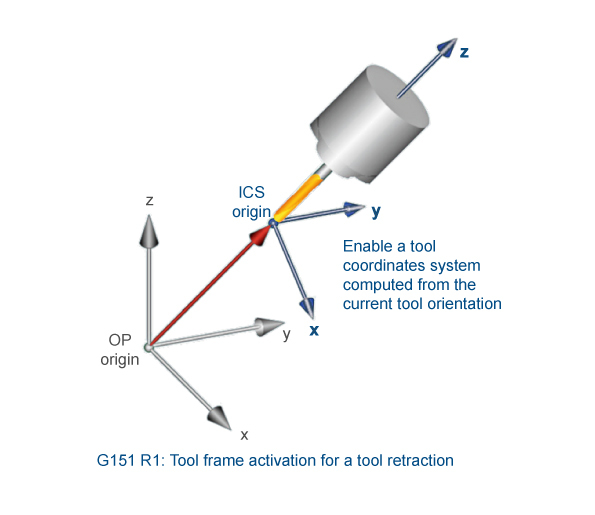 The RTCP function in NUM’s Flexium CNC software can now be activated by the actual positions of the rotary axes.
The RTCP function in NUM’s Flexium CNC software can now be activated by the actual positions of the rotary axes.
In some circumstances, aligning the workpiece to be processed on the machine can be a complex procedure. In these cases, to increase productivity, instead of moving the workpiece, NUM’s Flexium+ CNC system can now compensate for positioning deviations (including angles) by applying appropriate correction values. The workpiece remains misaligned, but the CNC system is aware of the deviations and compensates for them automatically.
NUM’s Flexium software, version 4.1.00.00 or higher, now features a special HMI (Human-Machine Interface) to allow the corresponding correction values to be entered. The coordinate system resulting from the shifts and rotations is called a ‘Balanced Coordinate System’ (or BCS) and the compensation function is known as 3DWPC (3D workpiece compensation).
Additionally, the software now includes a function to help machine users accelerate the roughing operation’s tunings and then achieve optimal surface finishes. Invoked by ISO code G732, the new function simplifies parameter optimisation and automatically computes pre-settings for roughing and finishing, with adjustable smoothing levels. The machine operator can select a range of attributes – such as profile tolerance, permissible chordal error and segment length – and invoke an optional smoothing algorithm to reduce mechanical shock and smooth the workpiece surface.
To further help machine operators achieve optimal results, NUM has also introduced a new algorithm that keeps the pivot point at constant speed. Part programs generated by CAD/CAM systems invariably comprise a multitude of small G01 segments – in the case of rotary axes, these are often distributed inhomogeneously – resulting in speed variations which affect surface quality. The new algorithms maintain constant speed at pivot points during the movement of rotary axes, allowing the discontinuities to be smoothed, resulting in an improved surface.
Five-axis machining, in which the tool is oriented in relation to the machining surface, has really come to the fore in the last few years. Machine tool builders are increasingly developing new kinematic configurations that capitalise on this technology, to help end-users further improve the performance of their machining operations.
A key factor behind the success of five-axis machining was the introduction of the Rotation Tool Centre Point (RTCP) function for CNC systems. NUM was an early developer of this function, which makes interpolated points track correctly by applying real-time compensation for the motion of the rotary axes.
For more information, please contact:
Steve Moore, NUM (UK) Ltd, Unit 3 Fairfield Court, Seven Stars Industrial Estate, Wheler Road, Coventry CV3 4LJ, UK.
Tel: +44 (0)2476 301 259; This email address is being protected from spambots. You need JavaScript enabled to view it.; www.num.com.
NUM AG, Battenhusstrasse 16, CH-9053 Teufen, Switzerland.
Tel: +41 71 335 04 11; This email address is being protected from spambots. You need JavaScript enabled to view it.; www.num.com.
Air Actuators from ContiTech Ensure Effective Operation of Forming Presses
Despite a great application of force, the air actuators are impressively durable • Tappet counterweight considerably reduces energy requirements • Air actuators enable controlled power transmission and clean machines
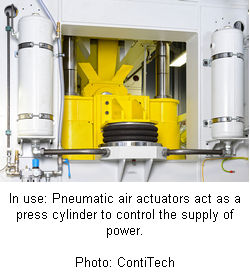 It is impossible to imagine the automotive industry without forming presses. They produce great force with which, for example, the metal parts for the body are shaped into their individual desired forms. But they are also increasingly used in other industrial sectors. Air actuators from ContiTech can be used in different positions in these gigantic presses. Depending on the use, they enable easy-to-control power transmission, clean machines, lower energy consumption, and a long service life for the equipment.
It is impossible to imagine the automotive industry without forming presses. They produce great force with which, for example, the metal parts for the body are shaped into their individual desired forms. But they are also increasingly used in other industrial sectors. Air actuators from ContiTech can be used in different positions in these gigantic presses. Depending on the use, they enable easy-to-control power transmission, clean machines, lower energy consumption, and a long service life for the equipment.
The core of a forming press is the "tappet." It moves up and down within a frame and holds the upper part of the mold for the pressing process. The lower part of the mold lies firm in the press equipment. After the sheet metal is inserted, the movement of the tappet presses both parts together and the sheet is shaped. The forming presses work at up to 80 strokes per minute. To make the tappet move, the large carrier mass must be put into motion and a lot of power is needed for this to generate up to 400 kN. This is mostly done using an engine. In order to minimize the need for energy as much as possible, modern forming presses have a tappet counterweight for which ContiTech's air actuators are also used. "For this reason, tappets mostly rely on multiple air actuators which bear the static weight," explains Dr. Olaf Kluth, segment head at ContiTech Air Spring Systems. "This design means that engine output is not necessary in the central position. The drive is only needed for the loading and unloading of the tappet. This allows energy to be saved and likewise mechanical components can be protected."
In this application, the air actuators work as an air spring. They do not have an air supply and produce a spring effect by compressing air using movement. Air actuators with large diameters of 600 to 700 millimeters are generally used to create the enormous power needed to bear the tappets.
As opposed to conventional pneumatic cylinders with sliding seals, ContiTech air actuators have considerable advantages. Sliding seals can quickly wear at approximately 80 strokes per minute. Downtime is necessary for servicing and replacing them, which means loss of production. ContiTech air actuators are different: they operate without sliding seals, are practically maintenance-free, and provide pressing companies with a long-lasting and energy-saving solution.
Controlled power and clean machines
In forming presses, air actuators can also be used within the tappet bolster. They sit directly in the tappet and cushion the affixed tool against impacts. For example, this can be molds like those used in the automotive industry to manufacture body parts. "The tools used can be fed in a controlled manner," says Kluth. "The power exerted can be individually adjusted. This achieves optimal results."
Another possible use for air actuators in forming presses is contained in the area above the tappet, where the tappet's upward and downward movement takes place. The mechanical components are set in a greasy medium which enables frictionless movement. The common sliding ring seals cannot, however, fully prevent liquid from leaking. As a result, the machine becomes increasingly dirty. To prevent this process, ContiTech has developed sealing bellows which are modified from an air actuator. "In practice, we have noticed that the sealing bellows also withstand high stroke rates and therefore the enormous loads in the forming press," explains Kluth.
ContiTech has decades of practical experience with the different uses of air actuators in forming presses. For years the air spring specialist has successfully worked together with leading manufacturers in the supply industry to develop individual solutions according to their needs. New developments are extensively tested in simulations and designed for practical application. The result? ContiTech air actuators make forming presses even more effective, cleaner, and more energy efficient.
Proof that engineering careers still appeal to UK youngsters!
 Scarborough's annual Engineering Week event aimed at encouraging youngsters to consider careers in engineering has just held its most successful event - attracting over 2700 schoolchildren and young students.
Scarborough's annual Engineering Week event aimed at encouraging youngsters to consider careers in engineering has just held its most successful event - attracting over 2700 schoolchildren and young students.
Almost 30 organisations - most from the Yorkshire region - put on educational and fun displays about jobs in engineering today. Many exhibits were hands-on and interactive and ranged from touch-screen computer-aided design software, to remote operated vehicles for subsea oil and gas work, robot arms, and even an ingenious piece of food processing automation - a rustic potato cleaning machine developed for a McCain Foods' oven chips TV commercial.
"Great Britain was built on the engineering revolution, and still today it's engineering prowess that is largely defining the growth and success of economies and nations," says Peter Wilkinson from the lead organiser Unison - the Scarborough-based manufacturer of tube bending machines. "As a country, the UK urgently needs to invest in engineering, and attracting more youngsters to enter the profession is critical to that purpose. This event is about just that - we set out to show just how interesting and rewarding engineering is - and it's making a big difference in our region."
Over three days, more than 2700 schoolchildren and teachers - plus many more at evening public sessions - toured the exhibition. Among these was the guest of honour, HRH Prince Richard The Duke of Gloucester, representing Queen Elizabeth II. Prince Richard has a strong technical background, having trained as an architect and worked as a partner in a London practice before taking up Royal and family duties. The Duke identifed wholeheartedly with the ambititons of the event - to attract UK youngsters to become the engineers of tomorrow - and said he'd like to come back next year. As might be expected, he took particular interest in Atlas Ward Structures' exhibit - which demonstrated CAD software the Scarborough-based company uses to design steelwork for world-renowned projects such as The Shard and the Queen Elizabeth Olympic Park.
The Scarborough Engineering Week event was conceived by the directors of the metalworking machinery builder Unison Ltd, and they led the organisation of this year's event. They were aided by the regional education business partnership NYBEP who organised the student attendance from regional primary, secondary, sixth form and further education schools and colleges. The event was made possible by sponsorship from York Potash who want to develop a mine in the Scarborough area to produce potash fertilizer - a very large scale enterprise which could create hundreds of high quality engineering jobs.
Schoolchildren were treated to an array of engineering products and technology from Atlas Ward Structures, Bluebird Vehicles, Castle Employment, Castle Group, Deep Sea Electronics, Dale Power Solutions, Derwent Training Association, F1 in Schools, Fanuc, Festo, Firmac, Forum Subsea Technologies, Hunprenco, Joy Global, McCain Foods, Moog, North Sea Winches, NYBEP, Osprey, Plaxton, Sainsbury's, Schneider Electronic, Unison, University of Hull, University of Sheffield Advanced Manufacturing Research Centre (AMRC), Wilfrid Scruton, Yorkshire Coast College, and York Potash.
Some 130 representatives from all of the organisations involved in the exhibition, as well as the attending schools and colleges, attended a celebratory dinner during the event at The Spa in Scarborough. Adrian Allen OBE of the Advanced Manufacturing Research Centre gave the keynote speech.
Scarborough Engineering Week ran from 14-16 October 2013, at The Spa in Scarborough.
